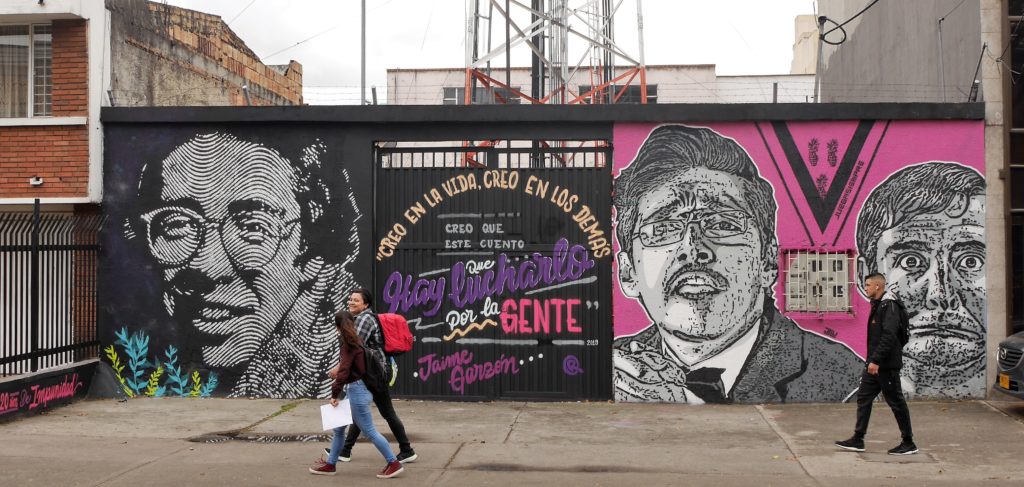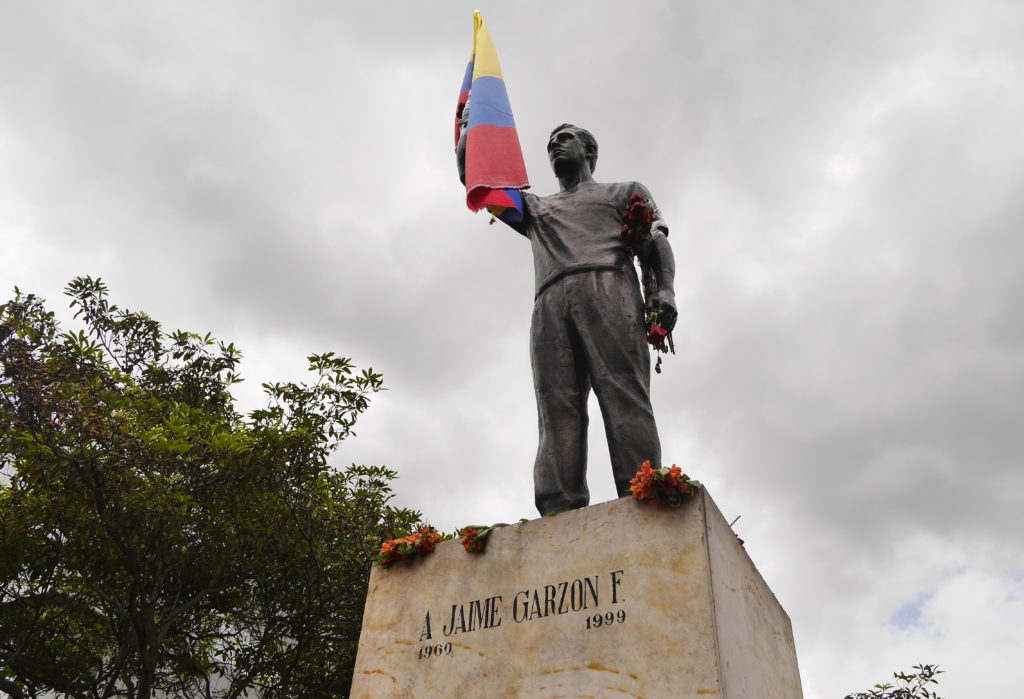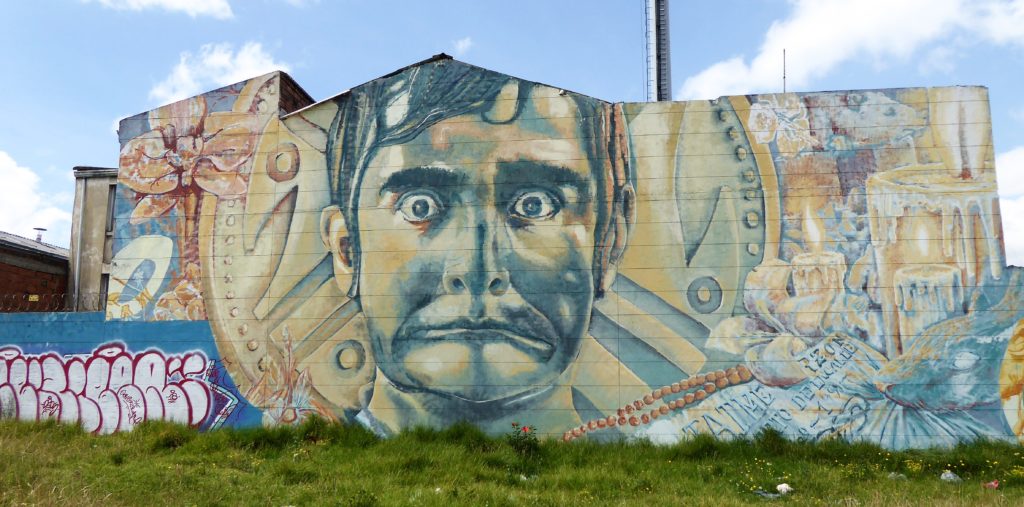Jaime Garzón: The day the laughter stopped

Jaime Garzón was assassinated on the streets of Bogotá 20 years ago. Here we remember Colombia’s best-loved – and deeply missed – comedian.
This article appeared in the Bogotá Post in August 2019.

If you’re new to Colombia, you might not have heard of Jaime Garzón, but you’ve surely seen his face: a bespectacled, goofy, visage that graces many of Bogotá’s walls in the form of popular graffiti, sometimes with his signature phrase ‘Pais de Mierda’ – ‘Shit Country’ – scrawled nearby.
Garzón had a passing resemblance to a duck, something he embraced (in one of his most recurring portraits he is, in fact, holding a duck) and he called his hilariously satirical current affairs show Quac.
Quac, which aired weekly on Canal Uno between 1995 and 1997, bid viewers ‘welcome to the best dis-information from Colombia and the world’ and proceeded to rip into the country’s state of affairs through a series of comical characters invented and mostly portrayed by Garzón himself.
‘Don’t take life seriously’
And no subject was off limits: presidents, politicians, bishops and society types were all lampooned by Garzón, a Bogotá-born extrovert who had studied politics at the Universidad Nacional but found his calling in humour. ‘Don’t take life seriously,’ was his enduring motto during dark days for Colombia with guerrillas dominating much of the rural areas and a surge in paramilitary groups.
But Garzón’s satire didn’t stop at the recognised elite. His skits took on paramilitaries, narco bosses, guerrilla commanders, journalists and his cast of characters included Quemando Central, a military chief spouting ultra-right nonsense, Compañero John Lennin, a radical lefty ‘always against everything’, Godofredo Cínico Caspa, a pompous political commentator, and Emerson de Francisco, an inept talk-show host.
Other much-loved alter egos were Dioselina Tibaná, a campesina cook with a side-line in tart political commentary, and Néstor Elí, ‘the door-keeper of the Colombia Building’ whose cheery utterings told a deeper truth of the country’s turmoil.
‘Rich people think they’re English. The middle-class pretend they’re Gringos. The intellectuals believe they are French. And the poor people think they’re Mexicans’. Jaime Garzón
Unsurprisingly, Garzón’s irreverent TV show and radio work was wildly popular with the wider population. He sketches skewered everyday ups and down of Colombians – check out the ‘racing buses’ sketch on Quac’s first ever show – and he could do stand-up comedy, often holding a mirror to society.

‘There are no Colombians, just people who share the same space,’ he once said, commenting on the country’s stratified population: ‘Rich people think they’re English. The middle-class pretend they’re Gringos. The intellectuals believe they are French. And the poor people think they’re Mexicans’.
But along with observational humour came a political edge. The comedian himself said ‘you have to laugh to think’, and Quac was both silly fun and recognised as the country’s most-watched ‘political opinion’ show.
Crossing the line
This was at a time when right-wing leaders branded journalists as ‘compliant in terrorism’ often resulting in death threats and killings. Now through comedy, Garzón’s skits risked revealing what mainstream media was reluctant to openly address: the deadly nexus between narco criminals, military bosses and the rising paramilitaries.
If Garzón was already treading thin ice, it got even thinner in 1998 when he became actively involved in a hostage negotiation with FARC guerrillas after a mass-kidnapping of 32 travellers on the Bogotá-Villavicencio road in March 1998.
This step from observer to actor in Colombia’s tangled conflict took Garzón into danger when he acted as mediator and ‘guarantor’, which put him temporarily with the FARC fighters in the Llanos while the Red Cross finalised the release of nine hostages.
Here’s where the story takes a strange twist: according to news website La Silla Vacia – quoting a Sociedad Interamericana de Prensa report from 2004 – during his interaction with the FARC, Garzón became aware that the guerrillas were buying weapons from corrupt officers in the army in Bogotá, and that the Colombian military were even supplying the FARC with kidnap victims.
This explosive information was not widely shared in 1998, though Garzón was widely quoted on his views that the country’s elite had ‘turned the conflict into a commercial enterprise’.
‘General, don’t seek enemies among Colombians who risk their lives daily to construct a dignified country’, Jaime Garzón, writing to the chief of the army in 1998.

Perhaps ironically – given that they were themselves supplying weapons to their enemy FARC forces – senior army commanders then branded Garzón a ‘friend of the guerrilla sympathisers’, a dog-whistle comment that frequently triggers a threat or assassination attempt against the accused.
Garzón tried to defuse the comments with a letter to the then army chief stating: ‘General, don’t seek enemies among Colombians who risk their lives daily to construct a dignified country’, but to no avail: in 1999 word came to Garzón that the paramilitary force Autodefensas Unidos de Colombia were planning his killing.
Shockwaves through Colombian society
Again, he took the initiative trying to meet in person with the army chief, and when that failed with the feared commander of the AUC, Carlos Castaño himself. A meeting was agreed with Castaño for August 14, 1999 in Córdoba, the hideout of the paramilitary cupola, but it never came to pass: Garzón was gunned down in his car close to Corferias in Bogotá the day before on August 13.
As news of the killing spread it sent a shockwave through Colombian society: widespread grief at the loss of the country’s beloved comedian, but also disbelief that someone so well-known could be murdered in daylight in the main city streets. People came out to march and mourn.
In the aftermath, people were asking: ‘If they can kill Jaime, who else can they kill?’, and the country entered a deep depression. For many, Garzón was not just a comedian, he was also a prophet, an interpreter, and a bright light on a grey conflict landscape.
Colombian prosecutors and intelligence service DAS were quick to pin the blame on Castaño’s paramilitaries, who in turn contracted the killing out to hitmen from La Terrazas narco group. But no-one really believed it ended there.

The four Las Terrazas hitmen were themselves murdered soon after, suggesting that someone was trying to cover tracks. Castaño was himself killed in 2004, though he had previously told colleagues that he arranged Garzón’s murder ‘as a favour to friends in the army’.
Later it became clear that DAS were laying a false trail, which when eventually uncovered led back to senior military figures who had asked their paramilitary amigos to do the deed. Eventually, in 2018, a formed DAS sub-director was sentenced to 26 years in prison as the ‘instigator’ of Garzón’s murder.
The shockwaves of his death reverberate 20 years down to today. This year other implicated military chiefs could face trial under the JEP special peace courts, hoping for a reduced sentence to telling the ‘whole truth’ on what they know of Garzón’s killing and other crimes.
Meanwhile the country has been gripped this month by continued scandals of army corruption and members of elite units’ involvement in extortion and kidnappings – the same crimes they are supposed to be preventing.
For many, it seems like Jaime Garzón is needed more than ever.
